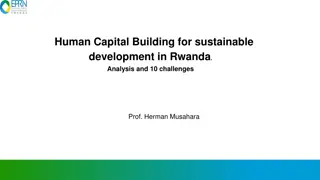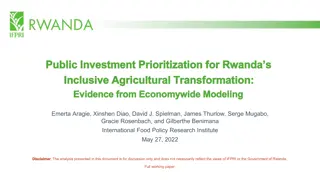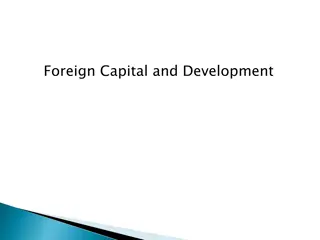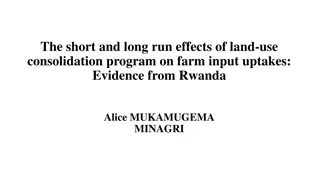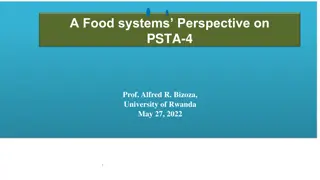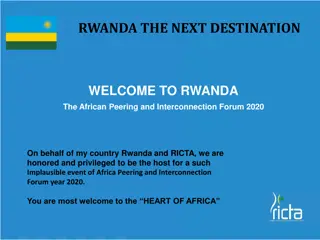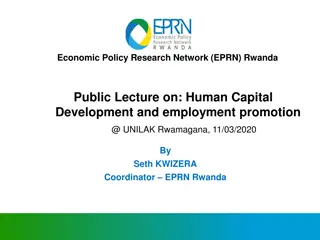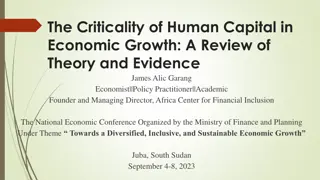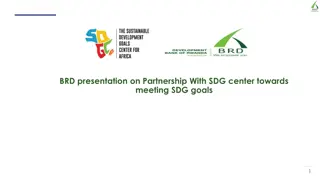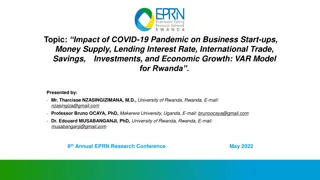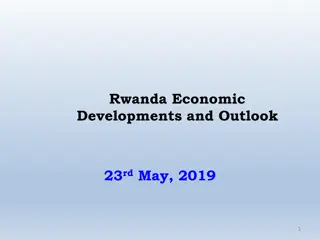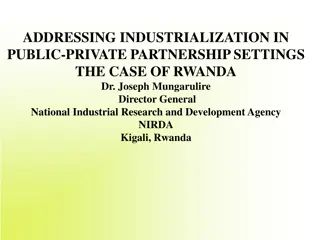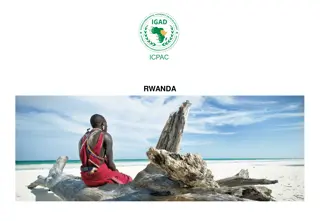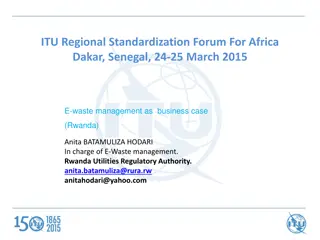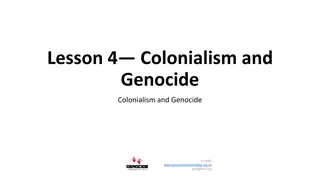Human Capital Development for Economic Growth in Rwanda: Challenges and Strategies
Rwanda's economic growth relies heavily on human capital development, but the impact of COVID-19 has posed significant challenges. This article by the World Bank Country Manager highlights the state of human capital in Rwanda, the effects of the pandemic, and strategies to protect and promote human capital.
Download Presentation

Please find below an Image/Link to download the presentation.
The content on the website is provided AS IS for your information and personal use only. It may not be sold, licensed, or shared on other websites without obtaining consent from the author.If you encounter any issues during the download, it is possible that the publisher has removed the file from their server.
You are allowed to download the files provided on this website for personal or commercial use, subject to the condition that they are used lawfully. All files are the property of their respective owners.
The content on the website is provided AS IS for your information and personal use only. It may not be sold, licensed, or shared on other websites without obtaining consent from the author.
E N D
Presentation Transcript
Human Capital Development: A key input to Rwanda s economic growth By Rolande Pryce, World Bank Country Manager, Rwanda April 20, 2021
I. II. State of Human Capital in Rwanda III. Impact of the COVID-19 on Human Capital in Rwanda IV. How to Protect and Promote Human Capital Post-COVID V. Role of the World Bank in Supporting Human Capital Development in Rwanda What is Human Capital? Outline
Key Messages Human capital is an essential pillar of Rwanda s development strategy Promoting human capital is critical for productivity and long-term growth Rwanda s human capital development faces important challenges that have been exacerbated by COVID Urgent and bold actions are needed to protect and promote human capital in post-COVID world Human capital is at the heart of the WB interventions in Rwanda.
Outline I. II. State of Human Capital in Rwanda III. Impact of the COVID-19 on Human Capital in Rwanda IV. How to Protect and Promote Human Capital Post-COVID V. Role of the World Bank in Supporting Human Capital Development in Rwanda What is Human Capital?
World Bank Definition of Human Capital What is human capital and why does it matter? Human capital consists of the knowledge, skills, and health that people invest in and accumulate throughout their lives, enabling them to realize their potential as productive members of society. Investing in people through nutrition, health care, quality education, jobs and skills helps develop human capital, and this is key to ending extreme poverty and creating more inclusive societies.
A Way of Thinking about Human Capital The life-cycle approach captures development of from conception to adulthood Human capital is critical for productivity and long-term growth: Education increases knowledge and skills which lead to higher productivity Well-educated and healthy people leverage knowledge and skills to adopt technology and innovate essential for productivity and growth 6
Human Capital in Rwandas National Strategy for Transformation Under Economic Transformation Pillar of National Strategy for Transformation (NST1) Support and empower youth and women to create business through entrepreneurship and access to finance. Working with private sector to Scale up the number of TVET graduates with skills relevant to the labor market. Ensure digital literacy for all youth (16 to 30 years) by 2024 through implementation of a national digital literacy program Under Social Transformation Pillar of NST1 Enhance the Demographic Dividend through Improved access to quality education Enhance the Demographic Dividend through ensuring access to quality health for all. Eradicate Malnutrition through enhanced prevention and management of all forms of malnutrition. 7
Outline I. II. State of Human Capital in Rwanda III. Impact of the COVID-19 on Human Capital in Rwanda IV. How to Protect and Promote Human Capital Post-COVID V. Role of the World Bank in Supporting Human Capital Development in Rwanda What is Human Capital?
Context: Trends in Human Capital-Related Outcomes Human Capital Index (HCI) 2020 HCI score (0.38) is lower than the Sub-Saharan Africa average and slightly higher than the average for low-income countries High stunting rate (33%), expected years of school (6.9 years), and weak learning outcomes (358 on a scale of 300-625) main contributors to low HCI score Gross secondary enrollment rate is only 43% and learning adjusted years of school is only 3.9 years DHS 2019-2020 and other key national indicators Stunting rate has fallen to 33% (38% in 2014-15), but progress is slow relative to Government's ambition of reducing stunting to19% by 2024. Stunting is highest in rural areas and among children aged 24-36 months. Stunting has also increased among infants, likely due to early start of complementary feeding Total fertility rate (4.1) has barely changed since 2014-15 when it was 4.2 (8.6% of 18-yr-old girls and 15.4% of 19-yr-old girls begin childbearing) Infant and child mortality achieved steep declines but are now stagnating, having only come down to 45 deaths per live births (U5) from 50 in 2014-15 Maternal mortality achieved steep decline: 98% of women attend at least 1 antenatal care check-up however, only 47% attend at least 4 ANC visits National Literacy rate (2018) is 77.6% for male and 69.4% for female population of 15 years and older.
Rwandas Human Capital Index: Girls perform better than boys Source: World Bank - Human Capital Project (HCP) 10
Outline I. II. State of Human Capital in Rwanda III. Impact of the COVID-19 on Human Capital in Rwanda IV. How to Protect and Promote Human Capital Post-COVID V. Role of the World Bank in Supporting Human Capital Development in Rwanda What is Human Capital?
Rwandas Human Capital in the time of COVID-19 (1) COVID has impaired health services The pandemic reduced health facility visits Led to reduced number of immunizations of children However, health services disruption seems temporary Declining household consumption and its impact on nutrition has the potential to increase stunting Outpatient health facility visits for treatment Patients newly initiated on antiretroviral treatment (ART) Source: Ministry of Health, Rwanda Source: Ministry of Health, Rwanda
Rwandas Human Capital in the time of COVID-19 (2) Learning losses are substantial An estimated 3.5 million students were out of school for much of 2020 The closure of schools has led to substantial learning losses. Learning losses are more pronounced among girls and the poor The productivity effect would likely be substantial for current students (from 10 to 30% of 2019 GDP over lifetime period) PV of lifetime earnings for all students (% of 2019 GDP) Learning adjusted years of schooling (schooling years) 3.9 580 No Covid-19 No Covid-19 10 0.2 3.7 570 Optimistic Optimistic 30 0.6 3.3 550 Pessimistic Pessimistic 1 1.5 2 2.5 3 3.5 4 4.5 0 100 200 300 400 500 600 700
Rwandas Human Capital in the time of COVID-19 (3) Rwanda extensive social safety net (SSN) made a difference REU-16 Simulations indicate that the expansion of social safety nets led to a 1.4 percentage point reduction in the poverty headcount ratio in 2020 Poverty reduction due to social protection (percentage points) ALL URBAN RURAL MALE FEMALE 0.0% The availability of strong agencies at central level and decentralized administrative apparatus facilitated the expansion of the social safety net once the pandemic hit -0.5% 2020 (with SSN expansion through Sept. 2020) -0.5% -0.5% -1.0% -1.4% -1.5% -1.4% 2021 (with SSN expansion to reach ERP targets) -1.5% -1.6% -1.7% -1.8% -1.8% -2.0% -2.0% -2.5% Source: Microsimulation estimates results
Poor Human Capital is a Major Challenge to Growth Fundamentals Rwanda underperforms its peers with similar incomes in terms of both the level of TFP and its growth rate (before the crisis) The pandemic likely exacerbated existing productivity challenges Rwanda s TFP vs global trends Declining contribution of the productivity to growth Sources of growth by factor inputs in Rwanda, 2001 2017 2014-2017 2010-2013 2005-2009 2001-2004 0% 10% 20% 30% 40% 50% 60% 70% 80% 90% 100% Capital stock Labour Total factor productivity Source. Extracted from World Bank SCD
Outline I. II. State of Human Capital in Rwanda III. Impact of the COVID-19 on Human Capital in Rwanda IV. How to Protect and Promote Human Capital Post-COVID V. Role of the World Bank in Supporting Human Capital Development in Rwanda What is Human Capital?
How to protect and promote human capital? Exceptional measures are required to protect and promote human capital The REU identifies measures in 3 policy areas: Save Lives Strengthen Policies, Institutions, and Investments for Rebuilding Back Better Protect Poor and Most Vulnerable
Saving Lives: Short term measures Vaccine deployment is the top priority: The equitable deployment of COVID-19 vaccines will be a true game changer The government should continue efforts to : Develop clear criteria for who will be prioritized for the vaccine, Provide training and technical assistance, Prepare for risk communication and community engagement It is also critical to strengthen efforts to protect the delivery of essential health and nutrition services to mitigate the risk of losing decades of progress
Saving Lives: Medium term measures Investing in preparedness and health security Despite important progress, Rwanda still has persistent gaps in disease outbreak preparedness and response capacity. Rwanda ranked 117 out of 195 countries on the Global Health Security Index, To strengthen the country s readiness level, It would be critical to fully finance and effectively implement the US$61.5 million National Action Plan for Health Security (2020-2024) prepared by the government, Authorities need to prioritize domestic financing and then leverage donor and private sector support to ensure sustainability.
Protecting the poor and the most vulnerable (1) Strengthen social safety nets Increase overall coverage of social safety nets: Further expansion in the coverage of the VUP, the gov flagship social protection program with special focus on expansion of HC focused programs (e.g. nutrition and early childhood related) Expanding social insurance to the informal sector Provide incentives for voluntary savings, increase access to financial services Improving targeting accuracy so social safety nets can be reach the deserving poor and be more cost-effective: EICV5 data analysis revealed that only 46% of households in Ubudehe 1 are actually poor, Through a more objective targeting tool such as household welfare scorecard, the share of poor households in Ubudehe 1 identified as such (for social support) can reach and go beyond 73 percent. Scaling up the use of digital cash transfers could help create a more responsive, safe and efficient delivery of social protection
Protecting the poor and the most vulnerable(2) Track and support reenrollment to ensure nobody is left behind: Targeted interventions for girls, children with disability, and low- income families Recover learning losses to prevent permanent impacts on the opportunities of children and youth: Improved teaching and school leadership Effective classroom assessment Structured pedagogy with focused remedial and catch-up programs Effective use of ICT for accelerated and multi-modal learning Enhance skills could for future growth, through: Improved digital skills for faculties and students Greater access to tertiary education in priority skills (example, health care professionals). Strengthen education systems with greater capacity: Greater accountability for learning outcomes, Increased focus on inculcating quality education leaders, Improved linkages of instruction with economic priorities and private sector needs
Strengthening policies, institutions, and investments for building back better Higher growth More inclusive More sustainable Expanding the role of the private sector - building on higher productivity supported by strong human capital
Measures to build back better (1) Because of the pandemic, public debt rose from 58.1 % of GDP end 2019 to estimated 72% end 2020 Expansionary fiscal policies are necessary to mitigate the impact of the pandemic However, over the medium-term, prudent fiscal management is critical to create fiscal space to support human capital development Strong domestic revenue mobilization Implementation of transparent and credible financial management practices Flattening the debt curve is critical to create fiscal space to invest on Human Capital Evolution of Public & Publicly Guaranteed Debt (percentage of GDP) 120 HIPC 100 80 Eurobond Issuance 60 40 20 0 2003 2004 2005 2006 2007 2008 2009 2010 2011 2012 2013 2014 2015 2016 2017 2018 2019 2020e 2021p Domestic debt External debt Public & Publicly Guaranteed Debt
Measures to build back better (2) Strengthening complementary infrastructures to boost human capital A reliable supply of electricity and greater access to high-speed internet is key It would not only increase the efficiency of remote learning but also help to reduce inequalities in access to better education tools. More broadly, increasing access to broadband internet will be critical to accelerate the structural transition to a more productive, modern economy.
Outline I. II. State of Human Capital in Rwanda III. Impact of the COVID-19 on Human Capital in Rwanda IV. How to Protect and Promote Human Capital Post-COVID V. Role of the World Bank in Supporting Human Capital Development in Rwanda What is Human Capital?
Human Capital for Inclusive Growth Project (DPO; $150 million) Pillar 1: Promoting long-term fiscal sustainability Pillar 2: Enhancing Coverage & Equity in Access to Critical Social Programs Pillar 3: Enabling learning and development of children Pillar 4: Strengthening decentralized capacity and accountability Basic Education Project (IPF; $210 million) Teacher preparation, effectiveness Better learning outcomes School readiness Adequate infrastructure COVID-19 response remote learning and back-to-school support Stunting Prevention Project (IPF; $55 million) High-impact Health and & Nutrition (H&N) interventions Stronger H&N delivery systems Multisectoral community & HH level prevention, management Students learn better and move to higher grades smoothly HUMAN CAPITAL AT THE HEART OF THE WORLD BANK PORTFOLIO IN RWANDA Children get a good head start Skills Development Project (PforR; $270 million) Increased access to quality and relevant skills Quality post-graduate capacity Institutional reforms Public private partnerships Social Protection Project (IPF; $103 million) Gender, child, and nutrition sensitive safety net CRVS including birth registration and certification systems Stronger SP delivery systems and M&E Young people with market-relevant skills transition to work Women are empowered to work, utilize their human capital Families face fewer risks to survival, health and well- being Higher Education Centers of Excellence (IPF-DLI; $20 million) Quality post-graduate education Collaborative research capacity Increased research in regional priority areas Rwanda COVID19 Emergency Response Project (IPF; $45 million) Effective COVID19 response Strengthened national health systems for public health preparedness ONGOING HUMAN CAPITAL RELATED ASA PROJECTS Rwanda Stunting Prevention and Reduction PASA ($255,000) Evaluation of Child- Sensitive SP ($600,000) Rwanda Reading: Books for early learning ($1 million) Disability Inclusion in Education ($1.9 million) Enhancements in Safety Net Delivery Systems ($200,000)
Murakoze Thank you





